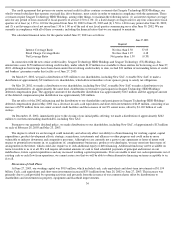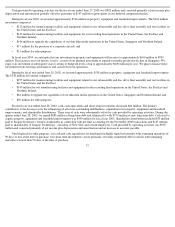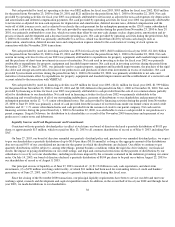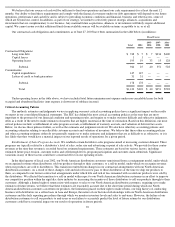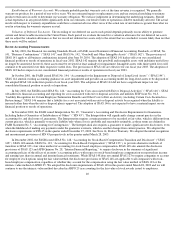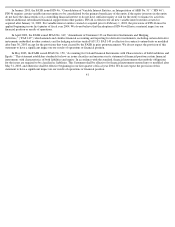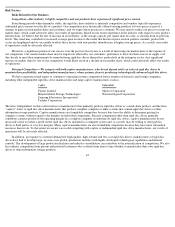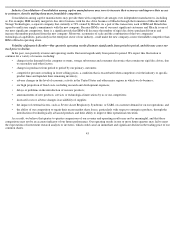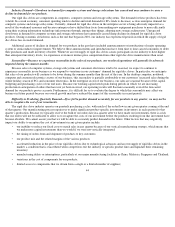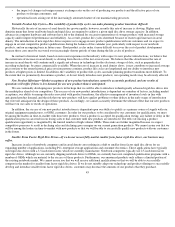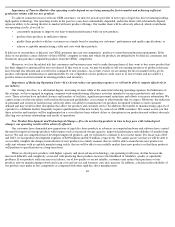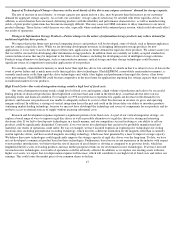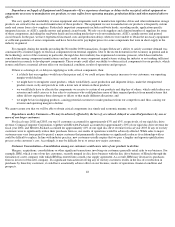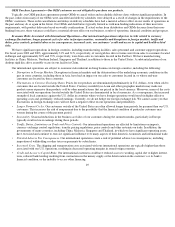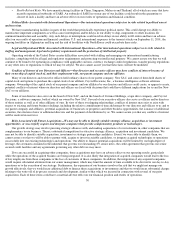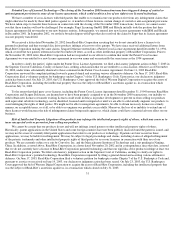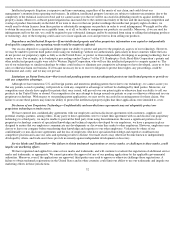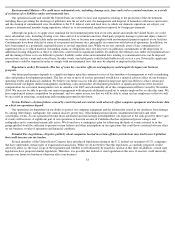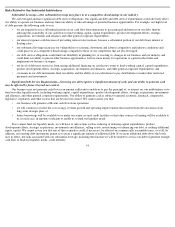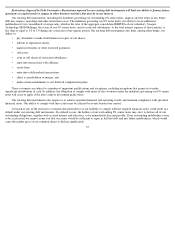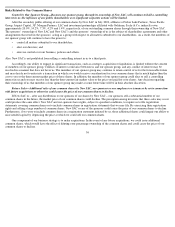Seagate 2002 Annual Report Download - page 51
Download and view the complete annual report
Please find page 51 of the 2002 Seagate annual report below. You can navigate through the pages in the report by either clicking on the pages listed below, or by using the keyword search tool below to find specific information within the annual report.
Importance of Time-to-Market—Our operating results depend on our being among the first-to-market and achieving sufficient
production volume with our new products.
To achieve consistent success with our OEM customers, we must be an early provider of new types of rigid disc drives featuring leading,
high-quality technology. Our operating results in the past two years have substantially depended, and in the future will substantially depend,
upon our ability to be among the first-to-market with new product offerings. Our market share will be adversely affected, which would harm
our operating results, if we fail to:
•
consistently maintain or improve our time-to-market performance with our new products;
•
produce these products in sufficient volume;
•
qualify these products with key customers on a timely basis by meeting our customers’ performance and quality specifications; or
If delivery of our products is delayed, our OEM customers may use our competitors’ products to meet their production requirements. If the
delay of our products causes delivery of those OEMs’ computer systems into which our products are integrated to be delayed, consumers and
businesses may purchase comparable products from the OEMs’ competitors.
Moreover, we face the related risk that consumers and businesses may wait to make their purchases if they want to buy a new product that
has been shipped or announced but not yet released. If this were to occur, we may be unable to sell our existing inventory of products that may
have become less efficient and cost effective compared to new products. As a result, even if we are among the first-to-market with a given
product, subsequent introductions or announcements by our competitors of new products could cause us to lose revenue and not achieve a
positive return on our investment in existing products and inventory.
Importance of Reducing Operating Costs—If we do not reduce our operating expenses, we will not be able to compete effectively in
our industry.
•
achieve acceptable manufacturing yields and costs with these products.
Our strategy involves, to a substantial degree, increasing revenue while at the same time reducing operating expenses. In furtherance of
this strategy, we have engaged in ongoing, company-wide manufacturing efficiency activities intended to increase productivity and reduce
costs. These activities have included closures and transfers of facilities, significant personnel reductions and efforts to increase automation. We
cannot assure you that our efforts will result in the increased profitability, cost savings or other benefits that we expect. Moreover, the reduction
of personnel and closure of facilities may adversely affect our ability to manufacture our products in required volumes to meet customer
demand and may result in other disruptions that affect our products and customer service. In addition, the transfer of manufacturing capacity of
a product to a different facility frequently requires qualification of the new facility by some of our OEM customers. We cannot assure you that
these activities and transfers will be implemented on a cost-
effective basis without delays or disruption in our production and without adversely
affecting our customer relationships and results of operations.
New Product Development and Technological Change—If we do not develop products in time to keep pace with technological
changes, our operating results will be adversely affected.
Our customers have demanded new generations of rigid disc drive products as advances in computer hardware and software have created
the need for improved storage products with features such as increased storage capacity, improved performance and reliability of smaller form
factors. We and our competitors have developed improved products, and we will need to continue to do so in the future. For fiscal years 2002
and 2003, we had product development expenses of $698 million and $670 million, respectively. We cannot assure you that we will be able to
successfully complete the design or introduction of new products in a timely manner, that we will be able to manufacture new products in
sufficient volumes with acceptable manufacturing yields, that we will be able to successfully market these new products or that these products
will perform to specifications on a long-term basis.
When we develop new products with higher capacity and more advanced technology, our operating results may decline because the
increased difficulty and complexity associated with producing these products increases the likelihood of reliability, quality or operability
problems. If our products suffer increases in failures, are of low quality or are not reliable, customers may reduce their purchases of our
products and our manufacturing rework and scrap costs and service and warranty costs may increase. In addition, a decline in the reliability of
our products may make us less competitive as compared with other rigid disc drive manufacturers.
46


